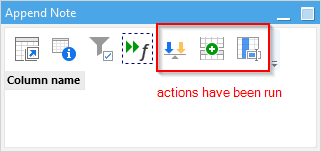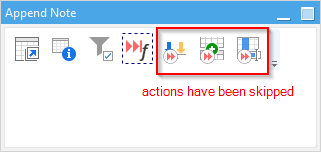Table of Contents
SKIP IF UNCHANGED
Category: Workflow / Internal
Description
This action skips the rest of the actions in the table if the current dataset did not change since the previous workflow run.
Use cases
- Provides a simplified way to detect dataset changes when a workflow is triggered by a Server trigger or by a Launcher task.
- This action allows for running additional actions - tests or modifications - to a dataset that has changed between workflow runs, and skip those actions if the dataset has not changed.
Action settings
| Setting | Description |
|---|---|
| Previous run | This displays the time-date-stamp of the last time the workflow was run. Use View dataset to review the dataset during the previous run. Press Forget to remove the last stored dataset. |
| Track changes in column(s) | Select which column or columns this action will detect changes in. |
| Change detection mode | Choose the type of changes to detect. Options: (first icon) Return added or changed rows compared with the previous run (will return any rows that were added or changed since the previous run), (second icon) Return missing rows compared to the previous run (will return rows that are now missing in the dataset since the previous run). |
| If skipped, the output is | Select what the output dataset of this action will be if this action is triggered and the rest of the actions are skipped. Options: Empty (an empty dataset is output) or Current dataset (and the incoming dataset to this action is passed along). |
| If the dataset from the previous run is missing | Choose how this action will respond when the previous dataset is missing. Options: Skip (skip the remaining actions in the table) or Do not skip (allow the remaining actions in this table to run). |
Remarks
When Previous run shows No information. Run this action at least once., there was no previous workflow run, or the user chose to remove the stored dataset from the previous run by using the Forget button. This action will need to be run at least once to store a dataset to compare to.
Examples
In the table below, the previous dataset changed (based on the Detection mode selected), and the subsequent actions have been executed (their pictograms show their default appearances).

Using the same table and mode, this time the dataset did not change, and the actions after the Skip if unchanged action are skipped (displayed with red arrows).

